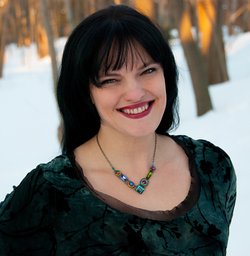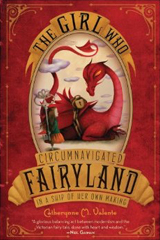Catherynne Valente, a Children’s Book Author for Adults
As a children’s book blogger and mother to a toddler, I’m an equal-opportunity lover of books, from board books to novels, and I’ve learned to largely ignore age recommendations. That’s how I found Catherynne M. Valente in the children’s book section rather than general fiction, and, trust me, she’s not an author to miss, no matter how you find her.
I first encountered Cat Valente’s books through her Fairyland series, novels which are listed for ages 10-14, according to the back cover. I’m 29 right now, by the way. I soon finished reading them all and delightedly reviewed them for my children’s books blog, The Children’s Bookroom, praising her for her ability to frame characters with such heart and personal growth, and to create a world so fantastical and yet so tangible. But I wanted more Valente books. I wondered what else someone with her capabilities would be able to do. Topsy-turvy adult that I am, I went from reading her children’s books to discovering her adult novels.
The next book by Valente which I read was Six-Gun Snow White, and that’s the novel I’m officially here to recommend to you. Six-Gun Snow White shares many of the fine characteristics of Valente’s children’s books: the story is laid out over a geography so clear you could map it; food and clothing and other objects are described with such precision that you could almost feel and taste them; the book is peopled with characters who nearly pop right out of the book to talk to you—while others fade into the shadows a little more, and you dearly hope they’ll stay there. But, of course, the real connection between Fairyland and Six-Gun Snow White is in the fairy tale. All of these books go back to the stuff of memory: where fairy tales come from.
Six-Gun Snow White is, as the title declares, the story of Snow White, but not as you’ve ever seen it told before; the entire story is a beautiful mosaic of fairy tale and Wild West. The story goes that a Nevada silver baron forces a beautiful Crow woman, Gun That Sings, to marry him. Gun That Sings gives birth to a little girl, but dies as she does. The girl is left to the care of her father and his house, and he creates all kinds of amusements for her, but keeps her hidden. When he remarries, this time to a beautiful golden-haired woman from New England with a mysterious past, the stepmother finds her stepdaughter and names her “Snow White” for what she will never be. Eventually, miserable in that house, Snow White runs away.
 And that brings me to one of Valente’s prime skills, whether in her children’s books or her adult novels: she’s a glorious narrator. In Fairyland, she’s an involved, mischievous, teasing narrator, but in Six-Gun Snow White she turns that clever unreliability to a more adult use. You see, at the beginning of our book, Snow White is our first-person narrator. She tells the story, and we see it all along with her. We watch through her eyes and her voice as the silver baron (whom she calls “Mr. H.”) courts her mother, offering her beautiful gowns which she rejects, and ultimately forces her to submit to the marriage. We watch through her eyes as she grows up in a big, fancy, uncaring home. We watch as the stepmother arrives and the house turns hostile toward her.
And that brings me to one of Valente’s prime skills, whether in her children’s books or her adult novels: she’s a glorious narrator. In Fairyland, she’s an involved, mischievous, teasing narrator, but in Six-Gun Snow White she turns that clever unreliability to a more adult use. You see, at the beginning of our book, Snow White is our first-person narrator. She tells the story, and we see it all along with her. We watch through her eyes and her voice as the silver baron (whom she calls “Mr. H.”) courts her mother, offering her beautiful gowns which she rejects, and ultimately forces her to submit to the marriage. We watch through her eyes as she grows up in a big, fancy, uncaring home. We watch as the stepmother arrives and the house turns hostile toward her.
And then, suddenly, as she runs away, the narrator tells us: “Girl deserves a rest, anyhow. You can tell a true story about your parents if you’re a damn sight good at sorting lies like laundry, but no one can tell a true story about themselves.” What does this mean for us, the reader? It means that as the story zeroes in more closely on Snow White and her bid for freedom, our hold on her thoughts and feelings peels away. Unreliable as a first-person narrator may be, we’re left with a distant third-person narrator. The loss of access to Snow White herself is an aching wound in the story, reflecting the pain and grief Snow White has already endured, and that which is still to come. As I said, Valente is a genius at playing with narrators.
This is the point in the novel where I don’t want to tell you too much more: yes, she does make her way to a mine, and, yes, she does find a safe haven full of seven people who want to protect her, but I assure you that you don’t want me to tell you much more than that. What I do want to do, though, is to circle back to where I started. This book is a retelling of a fairy tale. It’s told by the author of a popular series of children’s books about Fairyland and fairies. Certainly in both she shows a deep familiarity with fairy tales. How is that reflected in these books, and where do the differences lie?
In one fashion, there’s not much of a difference. Valente has a certain style, a knack for creating very real geography and texture in her books. She has a fundamental skill in crafting a new world, whether the target audience is 10-14 years old or much older than that. But in another sense, a fairy tale targeted toward adults gives her liberty—freedom to explore racial tensions, sexuality, and, simply, to say “fuck” if she thinks it’s appropriate. She’s allowed to get her hands dirty in a way that Fairyland doesn’t quite allow her to. And, on the other side, Fairyland gave her the scope of five novels to build an entire new world.
Let’s sum up: A good book is a good book, and should be enjoyable, whether the target audience is aged 8 or 88, and so my aim here is to introduce you to a fresh and original author of fairy tales to delight all ages: Catherynne M. Valente. I hope you enjoy reading her books as much as I do.
Deborah Furchtgott
Deborah Furchtgott is a PhD candidate in Celtic Languages and Literatures at Harvard. She writes a children’s book review blog covering picture books to YA novels at The Children’s Bookroom.
